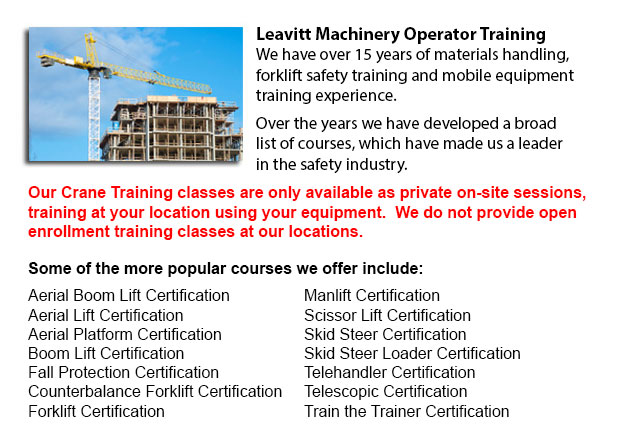
Vernon Overhead Crane Safety Training - The overhead crane safety training program is intended to equip the operators with the right knowledge and skills in the areas of: crane safety measures, materials handling, accident avoidance, and stock and equipment protection. Each of the trainees would get to learn on many kinds of overhead cranes, their capabilities and their uses in various environments. For operators who are trained and licensed, the shift in liability moves to the operator from the company. Thus, the course emphasizes individual operator tasks.
The operators in the overhead safety training course would be given instruction about the proper ways for performing checks: the more detailed in-depth inspection and the pre-shift inspection. These are important every day routines that must be logged. Correctly recorded pre-shift inspections help to protect the business from liability in the event of an accident. Pre-shift inspections likewise prevent damage, costly repairs and accidents. Operators learn how to designate a specific person to perform checks, how to maintain the log book and how to report problems.
Checks must be carried out on a regular basis and documented correctly. The following must checked while watching for usual problems: hooks for cracks, increases in the throat opening, degree of twist; hoist ropes for corrosion, worn wires, loss of diameter, bird caging and kinks, broken wires, chains for gouges and nicks, chemical and heat damage, corrosion and cracks, twists, excessive wear, distortion, stretching, pits, damage caused by extreme heat.
The operator would get to learn the correct techniques about right rigging procedures. The process of rigging involves the understanding of the manufacturer's data plate, determining the material weight to be lifted, choosing the gear, and utilizing safe practices to secure the load. The course include in detail the following: safe working loads, and the capacities of chains, ropes, hooks, shackles and slings.
It is important to understand who may operate the cranes at your facility, the job's physical requirements, and operator credentials needed for permits and specialized job. Safety is a top priority when utilizing near pedestrian traffic.
Safe crane use consists of responsibilities like for instance undertaking visual inspections, checking for hydraulic leaks, checking the safety guards, testing the controls, examining the hook and hoist rope, braking mechanisms and limit switches. Proper reporting methods are critical. These subject matters are all included in depth in the course.
Right moving and lifting methods with cranes and hoists are included in the program. Operators would become skilled in hand signals. Training involves how to raise the load, attach the load, set the load, unhook the slings and abort a lift.
Moving the load involves some steps: stopping and starting procedures, controlling and guiding the load, working with signals and observing working conditions. Operators should know how to proceed in case of a power failure. The course covers techniques for lowering the load and removing the slings, parking the crane, storage equipment, and securing an outdoor and indoor crane.
-
Vernon Heavy Equipment Training Programs
Vernon Heavy Equipment Training Programs - At whatever given construction site, there are often different types of machinery which are ready to be used. These heavy and light machines need both operators to run them and mechanics to fix them. Trainee... More -
Vernon Forklift Safety Training
Vernon Forklift Safety Training - People wanting work in industries that operate lift trucks should undergo a forklift safety training program before becoming a certified operator of a lift truck. There are a lot of ways to go about acquiring forklif... More -
Vernon Aerial Boom Lift Ticket
Vernon Aerial Boom Lift Ticket - Aerial platform lifts can accommodate various odd jobs involving high and tough reaching places. Normally used to complete regular preservation in structures with tall ceilings, prune tree branches, elevate heavy shel... More -
Vernon Manlift Safety Training
Vernon Manlift Safety Training - Manlift operators need to be cognizant and aware of all the potential dangers which are associated with particular classes of scissor lifts. They need to be able to operate the scissor lift in a way that protects not... More -
Vernon Forklift License
Vernon Forklift License - Obtaining a forklift certification or forklift license in North America will require the one training to carry out hands-on training in addition to classroom instruction. The provincial, federal and state regulatory bodies a... More -
Narrow Aisle Forklift, Order Picker, Electric Pallet Jack, Electric Pallet Truck Certification in Vernon
A pallet lift is a model of equipment dedicated in the transporting of pallets of many dimensions and weights. They can be utilized as an appendage for forklifts, cranes and other styles of heavy machinery or be applied on their own. Pallet hoists ar... More -
Vernon Boom Lift Safety Training
Vernon Boom Lift Safey Training - Boom lifts are a type of elevated work platform or aerial lifting device which are commonly utilized in construction, industry, and warehousing. Boom lifts can be utilized in practically any surroundings because of t... More -
Vernon Manlift Operator Training
Vernon Manlift Operator Training - The aerial lift or manlift is a specialized kind of hydraulic platform that is designed to lift a person vertically giving it an alternate name of a vertical personnel lift. These machinery are widely utilized for a... More

Forklift Certification Vernon
TOLL FREE: 1-888-254-6157
Vernon, British Columbia
forkliftcertificationvernon.com
Email Us
About Us


